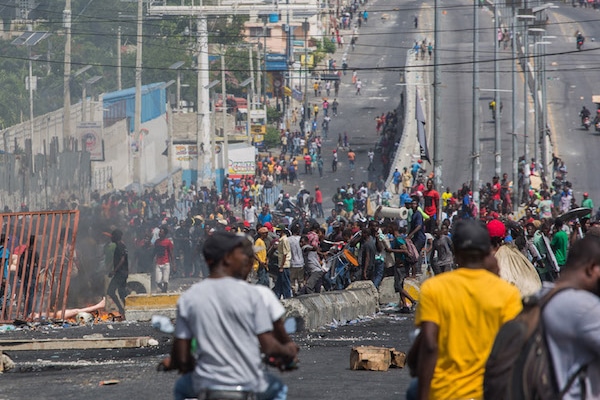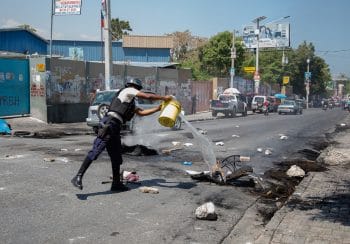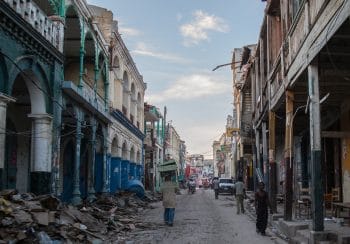In 1980, the magazine Tricontinental, published by the Organization of Solidarity with the People of Asia, Africa and Latin America (OSPAAAL), dedicated its issue no. 119 to Haiti. The editors wrote, ‘Very little is known about the Haitian people’s struggle,’ as the imperialists have ‘erected a wall of silence around Haiti’. They did not wish to see an international campaign develop to defend the people’s struggles—then against the dictatorial regime of the Duvalier’s, backed fully by the United States and its allies. ‘In spite of this,’ the editors wrote, ‘voices denouncing the murders and social injustice in Haiti can be heard over the wall, announcing the spread of the people’s struggle and calling for world solidarity with it’.
That wall exists today. Genuine understanding of people’s struggles is seldom developed outside that wall.
In July 2018, protests developed in Haiti and then escalated against the government. The immediate spur for the protests came when the government of Prime Minister Jack Guy Lafontant raised fuel prices by 38% (gasoline) and 51% (diesel and kerosene). The price rise was announced during the popular World Cup football match between Brazil and Belgium. It is thought that the government hoped to avoid public scrutiny of the price rise. No such luck for the Prime Minister. Within hours after the game ended, thousands of people took to the streets. They set up road blocks and expressed their anger against shops that sold goods unaffordable for the mass of the people.
The government hastily cancelled the price rise. But the protests did not end. More was at stake. The people made much bolder demands: for the Prime Minister to resign, for all those arrested during the protests to be released without charge, for the minimum wage to be increased. Prime Minister Lafontant, who was himself an unknown put into the position by Haiti’s President Jovenel Moïse, resigned. It took two weeks for Moïse to nominate his replacement—Jean Henry Céant, a man reviled for his role as the lawyer of land seizures (volè tè—or ‘land thief,’ as he is known). During the two weeks with no Prime Minister, the cord of power stretched from the President’s office to that of the head of the Haitian National Police—Director General Michel-Ange Gédéon. They are seen as illegitimate. Céant’s appointment has not helped.
The illegitimacy of the government comes out clearly by the name that the people give to their revolt—dechoukaj or uprooting. It is the same term used in the 1980s for the protests against the regime of Jean-Claude Duvalier. The people wanted him out. They want this government to be uprooted as well. These are very bold demands. They come from the depth of Haiti’s history, rooted in its revolution from 1791, deepened in its 1929 strike against the U.S. occupation and even further in the difficult struggles against the Duvaliers, and then made manifest in our time in the fights against austerity. The Haitian people rose up against the International Monetary Fund (IMF) policies in 1997 and then twice against fuel price rise (2000 and 2003). They are armed with a sense of independence and injustice.
Tricontinental: Institute for Social Research dossier no. 8 (September 2018) takes stock of the events that transpired this summer in Haiti and in their long-term meaning. The dossier is based on reports from the Jean Jacques Dessalines Solidarity Brigade of Brazil’s Landless Workers Movement (MST) and of Argentina’s Patria Grande. We are grateful to them for their detailed, on-the-ground report and to Camille Chalmers of Plateforme Haïtienne de Plaidoyer pour un Développement Alternatif (Papda) as well as Dr. Yvette Bonny for her work on the health crisis in Haiti.
The History of the ‘Bad Example’
Haiti’s present is shaped by its experience as an island of plantation slavery, a hub for the extraction of raw materials by super-exploited labour for the industrial boom in Europe and the United States. But this experience was blown into the air by the magnificence of the Haitian Revolution of 1791-1804. Haiti, in the late 18th and early 19th centuries, was the vanguard of humanity and of humanism. One cannot talk of Haiti unless one begins with the Haitian Revolution, the pioneer revolution in the Americas, the unthinkable revolution, a revolution of the cursed and the frustrated. It was a revolution that would be suffocated and betrayed, a revolution that the planter class and its backers tried to defeat. What if Haiti had been able to sustain its revolution? What would have been the fate of the Americans then?
The triumph of the Haitian Revolution—even for a few years—and the creation of a Black Republic is of great significance. The Trinidadian historian C. L. R. James, in his The Black Jacobins (1938), offered the clearest assessment of the Haitian Revolution.
The revolt is the only successful slave revolt in history, and the odds it had to overcome is evidence of the magnitude of the interests that were involved. The transformation of slaves, trembling in hundreds before a single white man, into a people able to organise themselves and defeat the most powerful European nations of their day, is one of the great epics of revolutionary struggle and achievement.
Nonetheless, despite its radicalism and despite its mass support, the Revolution failed to break with the dialectic of domination that had been set by mercantile capitalism. This failure was less a counter-revolution—a defeat, in other words—and more an ‘interrupted revolution,’ a concept offered by the Brazilian sociologist Florestan Fernandes (1980). There is no question that Haiti was inserted into a position of subordination in an unequal world capitalist system (Samsonov, 2010). But nonetheless, the Haitian people have continued to fight against this condition. Their revolution has been only interrupted, not defeated.
In the eyes of the imperialist powers, Haiti has been seen as a ‘bad example’. The idea of a slave uprising haunted the nightmares of the planters and their allies in Europe and the United States. The Haitian people, led by Jean Jacques Dessalines (1758-1806), rose in the spirit of the French Jacobin masses, led by Danton and Robespierre, and in the spirit of the indigenous Andean rebels, led by Tupac Amaru II. That the black, indigenous and peasant classes rose up and overthrew the apparatus of exploitation and subordination terrified the ruling classes.
The ruling classes could not tolerate this revolution. It had to be destroyed. Revolutionary Haiti was rapidly isolated and embargoed. The French and their allies, furious at the insolence of the Haitian people, penalised the new republic. In 1825, the French demanded that Haiti compensate the planters for their lost property—including human beings—as a condition for recognising the republic. If Haiti did not pay this compensation, France threatened a military occupation. Fourteen warships loomed on the horizon (Duval, 2017). France, which had already drawn every ounce of wealth from Haiti, now appeared as the creditor for the slave regime against the Haitian people. Haiti paid every last copper at onerous interest rates from the 1820s until 1947. The debt is valued today at $22 billion—an unimaginable amount for the country. The drain of this wealth left Haiti in a perilous state.
What was done to Haiti from 1825 anticipates what was done to Cuba from 1959.
In 1898, the United States asserted itself in the Caribbean, pushing out the Spanish in the Spanish-American War and occupying Cuba, the Dominican Republic, Haiti and Puerto Rico (Bosch, 2017). During the period of the U.S. occupation of Haiti, a Constitution was written in 1917 that enabled foreign ownership of Haitian land—which had been prohibited since the time of Dessalines—a leader of the Haitian revolution. Unrest against this law was put down by the Haitian Gendarmerie—an armed force created by the U.S. Marines to maintain ‘order’.
Fifteen thousand to thirty thousand Haitians died in the repression, though this did not stop a peasant rebellion in 1919- 1920 and a series of strikes in 1929. The leader of part of this unrest—Charlemagne Masséna Péralte (1886-1919)—and his band of cacos fought to defend the Haitian people’s rights. He was shot in the heart by a U.S. marine. Péralte was Haiti’s Sandino, the Nicaraguan revolutionary who met a similar fate in 1934.
The Haitian revolution was only ‘interrupted,’ not defeated.
Starting in 1950, the United States supported the successive dictatorships of François Duvalier (Papa Doc) and his son Jean-Claude (Baby Doc) for more than thirty years. The Duvaliers consolidated Haiti’s dependent and peripheral role in the world capitalist system. Widespread economic distress and the paranoia of the dictatorship led to the use of excessive violence to control the restive population. The Duvalier’s paramilitary formation
- the Tonton Macoutes, trained by the U.S. military mission—killed over 50,000 people in this period, deepening their anti- communist and anti-people ideologies into the society through fear and lies. Mass unrest overthrew the Duvalier regime in 1986.
But the new country entered its democratic phase impoverished by the Duvaliers and their cronies. Haiti went to the IMF, which—along with the U.S. State Department—‘recommended’ a compulsory policy of trade liberalisation. There was no forgiveness for the odious debts—debt incurred by a dictatorship with no input from the people. Attempts to fight this system through the movement of the people—the movement known as the flood (lavalas), led by the former priest Jean-Bertrand Aristide—were twice set aside through the coups of 1994 and 2004. Pushed by the United States and its allies, the United Nations sent in the UN Stabilisation Force in Haiti (MINUSTAH) in June 2004. In 2017, the Associated Press published a detailed investigation that showed the UN force as a ruthless occupying army. The evidence showed thousands of cases of rape and torture as well as the dissemination of a cholera strain—a disaster for Haiti. Thepeacekeeping force was implicated in everything that is against its mandate.
The penalties incurred by the Haitian people were magnified by the earthquake which struck the country in January 2010. More than 300,000 people died in this tragedy. Once more, Haiti was not to be the destination for the world’s humanitarian feeling. Rather, the IMF used this crisis to increase Haiti’s dependency by granting the country a loan of $114 million. The terms of this loan have continued to asphyxiate Haiti’s sovereignty in the years since. What the country needed was solidarity, not usury.
Haiti’s history has been marked by conquest, occupation and tutelage. Violence and debt define the external world’s relationship with Haiti. There is a racist temptation to blame the Haitians for their problems or else to see their tragedies as foisted on them by the whims of nature. None of these explanations are accurate. They avoid the obvious: the role of the brutal Atlantic triangular trade between Europe, Africa and the Americas (Grüner, 2010) and the refusal by the West to allow Haiti to breathe. The same story of dependency and rebellion repeats in sequence: from the French bankers of the 19th century to the IMF of the 21st century, from the counter-revolutionary armies of General Charles Leclerc to the UN’s MINUSTAH, from Napoleon to Bill Clinton, from merchant capital to finance capital, from plantation to plantation, from sugar monoculture to the ruination of rice. The dialectic between subordination and struggle is at the heart of Haiti’s history.
Break from the Past
Just before the Haitian Revolution, the French colonist La Barre wrote to his wife,
There is no movement among our Negroes…They don’t even think about it. They are very tranquil and obedient. A revolt among them is impossible…The Negroes are very obedient and always will be. We sleep with doors and windows wide open. Freedom for them is a chimera (Trouillot, 2017).
The imperialist expects the subordinate to remain so in perpetuity. In 1791, as in 2018, that illusion was shattered by events.
A mass popular uprising began in Port-au-Prince, the capital of Haiti, on July 6, 2018 and then spread rapidly to the rest of the country. The protests were radical; the people took charge of the streets within a few hours. The National Police withdrew to its barracks. The repertoire of street actions included people’s mobilisations, the creation of barricades, the burning of tires, the looting of shops and supermarkets, as well as the burning of the offices of transnational firms, luxury hotels and government offices. Twenty people died and an indeterminate number were injured. In response to the protests, a wide range of unions, urban and peasant organisations and others called for a mobilisation to the National Palace and for a general strike on July 9-10. This strike completely paralysed the country, helped along by the total shutdown of transport by its unions. It was a sign of the wide support that the people gave to this unrest.
What sparked the uprising was the rise in fuel prices—and the manner in which the price rise was decided and introduced. In May, the government signed an agreement with the IMF. In that agreement, the IMF agreed to back the infusion of dollars to allow Haiti to pay its creditors. In return, Haiti was to introduce IMF ‘reforms,’ including the removal of fuel subsidies. The Inter-American Development Bank offered Haiti an additional US$40 billion, if Haiti agreed to hasten its commitments to the IMF ‘reform’ package. The Bank wanted Haiti to not only remove the fuel subsidy, but to also privatise the Haiti electricity company (EDH—Electricité d’Haiti). Higher prices for fuel and for electricity—a necessary outcome of privatisation—would put an enormous burden on the working-class and the poor of this society impoverished by theft.
Haiti is the poorest country in the Americas. It is also one of the most unequal societies in the world. It has the lowest Gross Domestic Product (GDP) in the Western Hemisphere. The minimum wage in the ‘free trade zones’ for export- oriented manufacturing is less than $5 per day, while 58% of the population survives on less than $2 a day (UNDP). Hunger and food insecurity stalk 6 million of the 10 million Haitians (FAO). Official inflation rates are at 15%, but everyone knows that the prices gallop at speeds that are not counted by the state. The national currency (the gourde) constantly depreciates against the U.S. dollar. Most of the national infrastructure—weakened by the 2010 earthquake—remains in a poor state. Rural Haiti suffers from total neglect, with its agriculture starved of capital investment. The health and education sectors are almost totally privatised, rendering them inaccessible to large sections of the population. Haitian public finances are miserable, with salaries unpaid and wealth embezzled to offshore tax havens.
In this context, it is easy to see why one million people could take to the streets—one in every ten Haitians. Fuel prices catalysed the unrest. But this was not an unrest about fuel prices alone. The radical energy unleashed by the protests could not be contained by the withdrawal of the rise in fuel prices or by the repression. This was dechoukaj— an uprooting.
The Uprooting
The protests in Haiti in 2018 are not unfamiliar. They are similar to protests across the world from the 1989 Caracazo in Venezuela to the 2011 Tahrir protests in Egypt. These are protests with a decidedly urban character in a country that is largely rooted in the countryside. They are a protest against misery.
The Peasant Question. Half of Haiti’s workers are employed in agriculture, even as that sector only contributes 25% to the country’s GDP. Trade liberalisation policies of the IMF reduced tariffs on agricultural imports, discouraged investments in agriculture, increased rural unemployment, induced migration to the overpopulated capital and produced a workforce to stand in the queues of the small factories inside the ‘free trade zones’. Where Haiti was once self-sufficient in rice production, it now imports vast quantities of rice from the United States. The main protagonist in the 2018 struggle was the urban working-class and the poor, with little participation of the peasantry—the agricultural workers and the small peasants.
Agents of History. That the agricultural workers and small peasants did not participate in large numbers in a country with a large peasantry leads us to consider the classic debate in Marxist theory about the agent of social transformation. Since Lenin’s contribution of the theory of the worker-peasantalliance for the 1917 Russian Revolution, it has become axiomatic that in ‘peasant societies,’ the worker-peasant alliance is fundamental for revolutionary change. In places such as Haiti, the gap between the urban workers and the rural peasants—even if bridged through families—is wide in political terms. The migration from the countryside to the city has created a large ocean of the impoverished. This population—the outsiders of society—has become central to the cycle of anti-neoliberal insurrections (as during the Water and Gas Wars in Bolivia and during the popular rebellions in Argentina). Attention towards the lack of a worker-peasant alliance and towards this dispossessed urban population is necessary.
Spontaneity. The demonstrations spread with rapidity, as calmness turned into a general insurrection in a few hours, but then swept back to demobilisation in a few weeks. Certainly, there were organised forces involved at the start and in the maintenance of the demonstrations, and indeed these forces did drive the general strike in July. In many parts of the country, the protests unfolded spontaneously, but appeared nonetheless to demonstrate an intelligence: the dispossessed masses ‘wrote’ their frustrations onto the landscape of the city. Evidence of this comes out most graphically in the way in which the masses attacked the institutions of luxury—the hotels and shops, the embassies and government buildings. The collective rage of the population drives such attacks. The collapse of the insurrection, on the other hand, shows the weakness of spontaneity—a point made in the classic debate on these issues between Lenin and Rosa Luxemburg. It is clear that whereas the first (spontaneity) is inevitable, the second (organisation) is essential.
Protest, Not Revolution. There is no revolution in progress in Haiti. To believe that the events of July are a revolution is too optimistic an interpretation. What we have in such anti-neoliberal protests is an outburst of energy, a rebound against the harshness of neoliberal policies. Capitalism and the neoliberal policy framework have hit societies hard, disarticulating social and political life, and have left people in desperation. The spontaneous uprisings are a reaction to this desperation. They are not an example of the emergence of a new cycle of class struggle or an expression of a robust ideological and organisational development. Residues of class resentment exist, but these have not been channeled into movements and organisations. The resolution of these crises and the success of the uprisings they produce depend on a variety of factors, notably the development of organised forces of the people. Without such preparation through organisations, an outbreak is easily defeated. The ruling class uses such a defeat to consolidate its own power with great vehemence.
There is no need to be overly pessimistic. The mass insurrection of July 2018 reminds us of the ‘interrupted revolution,’of the whispers in the wind that organise outside the earshot of the ruling classes. Despite centuries of pillage and social devastation, the Haitian people incubate their traditions of rebellion. In 1962, C. L. R. James published a new edition of his study of the Haitian Revolution (Black Jacobins). This time, James added an appendix that opened by comparing the Haitian Revolution of 1791 with the Cuban Revolution of 1959. When C. L. R. James put pen to paper, the United States and its allies had embargoed Cuba and had used every means to overthrow the Cuban Revolution. They were not able to succeed. The words that James wrote to define the character of the rebellions in the Caribbean remain as true today as they did in 1962,
In a scattered series of disparate islands, the process consists of a series of uncoordinated periods of drift, punctuated by spurts, leaps and catastrophes. But the inherent movement is clear and strong.
Bibliography
- L. R. James, The Black Jacobins: Toussaint L’Ouverture and the San Domingo Revolution, New York: Vintage, 1963.
- Dmitri Prieto Samsónov, Transdominación de Haití, Ciudad de La Habana, Instituto Cubano del Libro, Editorial de Ciencias Sociales, 2010.
- Eduardo Grüner, La oscuridad y las luces: capitalism, cultura y revolución, Buenos Aires, Edhasa, 2010.
- Florestan Fernandes, A natureza sociológica de sociologia, São Paulo, Ática, 1980.
- Jérôme Duval, ‘Haïti: De la traite à la dette,’ Politis, Septembre 19, 2017.
- Juan Bosch: Para comprender Haití, ed. Matías Bosch Carcuro, Santo Domingo, Fundación Juan Bosch, 2017.
- Michel-Rolph Trouillot, Silencing the Past, Boston: Beacon Press, 1997.






